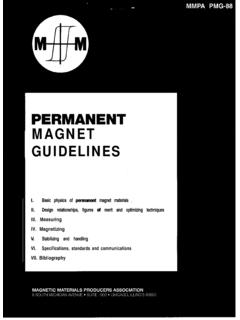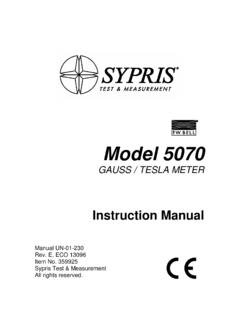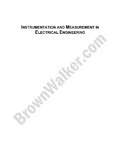Transcription of Modeling and Simulation of Permanent Magnet …
1 International Journal of Electrical Engineering. ISSN 0974-2158 Volume 7, Number 3 (2014), pp. 413-423 International Research Publication House Paper Code: 14518 ijee new file1 Modeling and Simulation of Permanent Magnet Synchronous Motor using MATLAB 1 Ram N. Hajare and 2 Archana G. Thosar Student, Electrical Engg. Dept. Govt. College of Engg, Aurangabad, India 2 Associate Professor & Head, Electrical Engg. Dept. Govt. College of Engg, Aurangabad, India Abstract: This paper presents, the mathematical model of a field oriented controlled Permanent Magnet motor drive system which is developed & simulated in MATLAB-simulink. Today in many industries (especially in machine tool industry) the use of Permanent Magnet Synchronous Motor (PMSM) is increasing due to smaller size, less weight & low rotor loss compare to induction motor of same capacity.
2 One of the important characteristics of Permanent Magnet Synchronous Motor is that they produce constant torque with sinusoidal stator current. The Simulation model includes all the required component of the drive system. Due to this the calculation of current and voltages in different parts of the inverter and motor under transient and steady conditions are possible. A closed loop control system in the speed loop has been designed to operate in constant torque and flux weakening regions. The principle of speed control is verified by analyzing the variation in the results of speed & torque. Keywords: PMSM motor, Field Oriented control, constant torque. I. Introduction Permanent Magnet Synchronous Motors (PMSM) are widely used in low and mid power applications such as computer peripheral equipment, robotics, adjustable speed drives and electric vehicles.
3 The growth in the market of Permanent Magnet motor drives has demanded the need of Simulation tools capable of handling motor drive simulations. Simulations have helped the process of developing new systems including motor drives, by reducing cost and time. T. Sebastian [1] reviewed Permanent Magnet Synchronous Motor advancements and presented equivalent electric circuit models for such motors and compared 414 Ram N. Hajare and Archana G. Thosar computed parameters with measured parameters. Experimental results on laboratory motors were also given. P. Pillay in [2] presented Permanent Magnet motor drives and classified them into two types such as Permanent Magnet Synchronous Motor drives (PMSM) and Brushless DC Motor (BDCM) drives.
4 The PMSM has a sinusoidal back emf and requires sinusoidal stator currents to produce constant torque while the BDCM has a trapezoidal back emf and requires rectangular stator currents to produce constant torque. B. Cui [3] addresses the Modeling and Simulation of Permanent Magnet synchronous motor supplied from a six step continuous inverter based on state space method. The motor model was derived in the stationary reference frame and then in the rotor reference frame using Park transformation. The Simulation results obtained showed that the method used for deciding initial conditions was very effective. In this paper Simulation of PMSM is done in MATLAB Software. The control of speed is implemented using speed control & torque control loops.
5 The results of Simulation are discussed. The result obtained validates the advantages of PMSM motor. II. Basic Model of the System. The motor drive consists of four main components, the PM motor, inverter, control unit and the position sensor. The components are connected as shown in Figure 1. Figure 1: Schematic of the Drive System The main components of the system are: 1. Permanent Magnet Synchronous Motor 2. Various Position Sensors Optical Encoders Optical encoder is very popular type of encoder in industry. This consists of a rotating disk, a light source, and a photo detector. The disk, is mounted on the rotating shaft, has coded patterns of opaque and transparent sectors. As the disk rotates, these patterns interrupt the light emitted onto the photo detector, generating a digital pulse Modeling and Simulation of Permanent Magnet Synchronous Motor 415 or output signal.
6 Incremental encoders Incremental encoders have good precision and are simple to implement but they suffer from lack of information when the motor is at rest position and in order for precise position the motor must be stop at the starting point. Absolute encoders The absolute encoder exact position of the rotor with a precision directly related to the number of bits of the encoder. It can rotate indefinitely and even if the motor stops, the position can be measured or obtained. Position Revolver Position revolver is also known as rotary transformers. It works on the transformer principle in which the primary winding is placed on the rotor. Depending upon the rotor shaft angle the induced voltage at the two secondary windings of the transformer is shifted by 90.
7 The position can be calculated using two voltages. 3. Inverter Voltage Source Inverters are devices that convert a DC voltage to AC voltage of variable frequency and magnitude. They are very commonly used in adjustable speed drives and are characterized by a well defined switched voltage wave form in the terminals. 4. Controller The controller will generate the reference currents with the inverter within a range which is fixed by the width of the band gap. In this controller the desired current of a given phase is summed with the negative of the measured current. The error is fed to a comparator having a hysteresis band. When the error crosses the lower limit of the hysteresis band, the upper switch of the inverter leg is turned on.
8 But when the current attempts to become less than the upper reference band, the bottom switch is turned on. 5. Load For inverter power electronics switches are used. The switch is selected on the basis of its power capability and switching. Table 1 shown below illustrates power devices and their switching capabilities. Table 1: Devices Power and Switching Capabilities Device Power Capability Switching Speed BJT Medium Medium GTO High Low IGBT Medium Medium MOSFET Low High THYRISTOR High Low 416 Ram N. Hajare and Archana G. Thosar Current regulators for AC drives are complex because an AC current regulator must control both the amplitude and phase of the stator current. The AC drive current regulator forms the inner loop of the overall motion controller.
9 As such, it must have the widest bandwidth in the system and must have zero or nearly zero steady-state error. Both current source inverters (CSI) and voltage source inverters (VSI) can be operated in controlled current modes. The current source inverter is a natural current supply and can readily be adapted to controlled current operation. The voltage source inverter requires more complexity in the current regulator but offers much higher bandwidth and elimination of current harmonics as compared to the CSI and is almost exclusively used for motion control applications. III Equivalent Circuit of Permanent Magnet Synchronous Motor Equivalent circuits of the motors are used for study and Simulation of motors.
10 From the d-q Modeling of the motor using the stator voltage equations the equivalent circuit of the motor can be derived. Assuming rotor d axis flux from the Permanent magnets is represented by a constant current source as described in the following equation = , illustrated in the below Figure 2. Figure 2: Permanent Magnet Synchronous motor Electric Circuit without Damper Windings Detailed Modeling of PM motor drive system is required for proper Simulation of the system. The d-q model has been developed on rotor reference frame as shown in any time t, the rotating rotor d-axis makes and angle with the fixed stator phase axis and rotating stator mmf makes an angle with the rotor d-axis.








